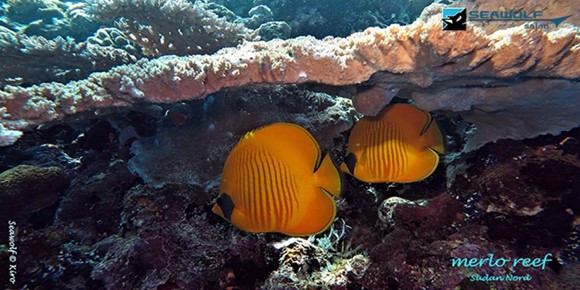Overview
The longish reef is located 1.2 nautical miles southwest of Angarosh. Like Angarosh and Abington Reef, it rises steeply from the seabed, which is over 450 meters deep.
Description
West side
On the west side you can see the remains of the Freedom from far away. The Austrian safari boat ran into the reef due to a navigation error in October 1999. The ship was almost completely stripped by local fishermen within a few days - in the meantime only the stripped hull and the sawed off bow can be seen. The Merlo Reef is frequently visited by safari boats. Because of its exposed position, currents must be expected here as well, although they are usually not as strong as at Abington Reef.
East side
The reef wall is partly overhanging to a depth of about 15 meters.
In this area the reef is very rugged with many crevices. Numerous giant moray eels find a hiding place there and wait for the night to stalk their prey under cover of darkness. Some crevices are so large that it is easy to dive into them.
Inside, scattered coral dwellers can be spotted in the diffused light, hiding from their enemies. At the foot of the wall begins a slightly downward inclined slope with beautiful vegetation. It is littered with small to medium sized coral blocks and populated by many reef dwellers. The coral growth is so dense that only small sandy areas can be found on which occasional whitetip sharks rest.
In addition to the various species of hard and soft corals, there are a large number of table corals spread over the entire eastern side.
Colonies of splendid and bubble anemones have settled next to them and schools of unicorn fish swim on the slope. At its end, the outer wall drops steeply into the depths. The edge runs north at a depth of about 40 meters and rises to the south to the 25 meter range. In this section, groups of napoleons move along the reef and curiously approach the divers swimming by.
At the northern tip is a three-level plateau. The first level covers the shallow water area to a depth of 2 meters. On the west side, two deep cuts can be easily dived and under a small overhang at 15 meters is a school of glassfish. At the foot of a craggy reef wall, the second stage begins in 25 meters. The bottom drops deep to 30 meters to turn into a steep wall. The plateau is nicely vegetated, but dominated by a large coral rock on the west side. It is beautifully overgrown with soft and hard corals and offers interesting motifs for underwater photographers. Below it, the third plateau level can be spotted.
Hotspots
- Among other things, you can see numerous Indo-Pacific sergeants, various snapper species and butterfly fish. With a little luck, grey reef sharks can be seen on the steep wall. Occasionally you can also see groups of hammerhead sharks passing by.

 ENGLISH
ENGLISH
 РУССКИЙ
РУССКИЙ
 DEUTSCH
DEUTSCH

